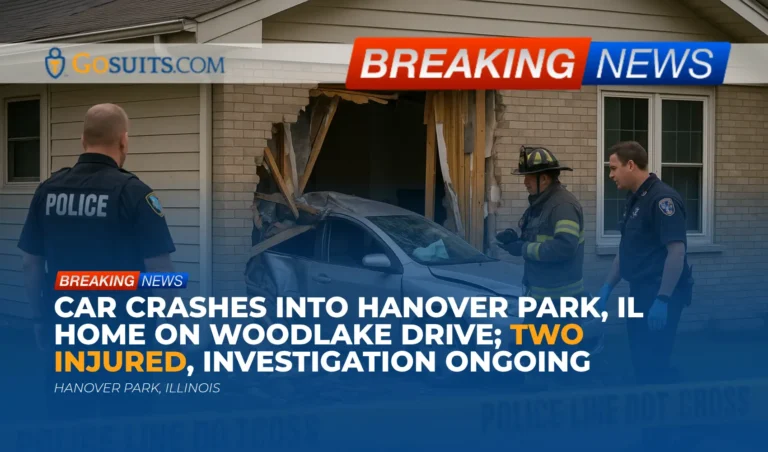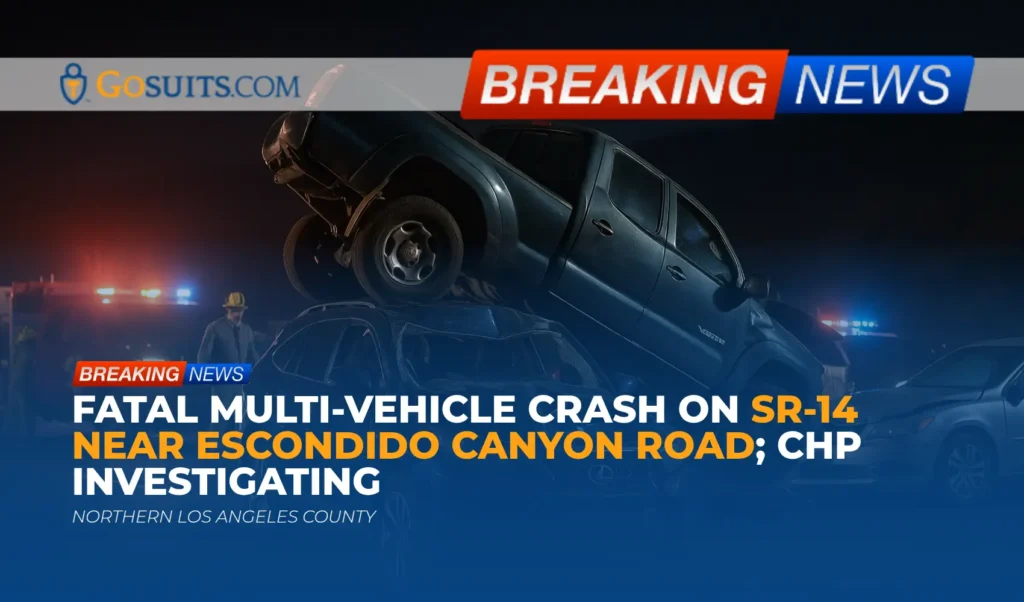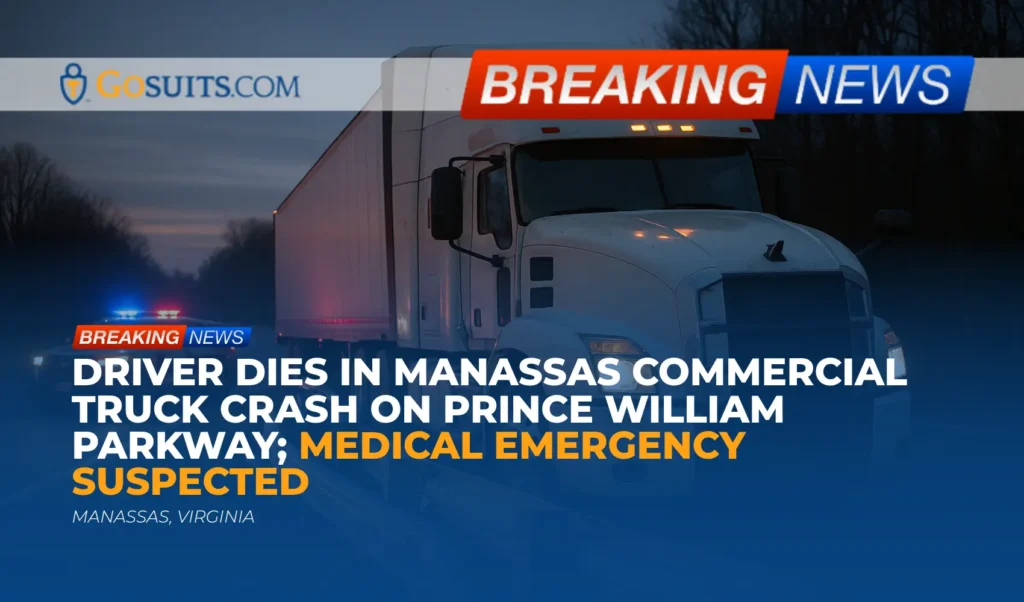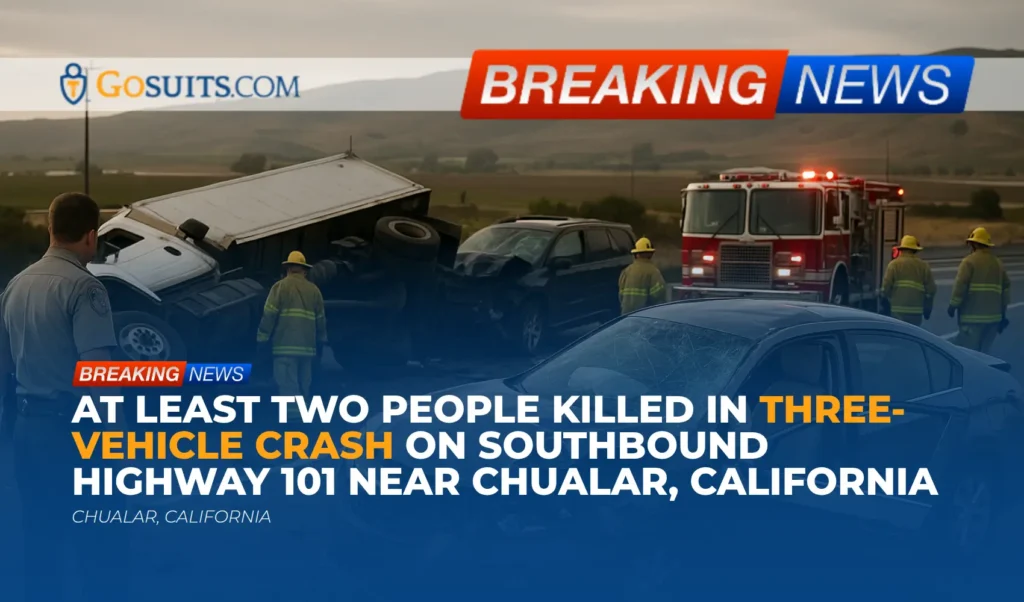- What we know about the Hanover Park house crash on Woodlake Drive
- Immediate safety and structural concerns after a vehicle hits a home
- Who investigates and what records exist, how to request them
- Rights of injured residents and drivers under Illinois civil law
- Possible avenues of compensation and insurance coverage
- How liability may be evaluated in a vehicle into home crashes
- Timelines that matter in Illinois claims
- Practical next steps for families after a crash into a residence
- Data and context on roadway departure crashes
- Where to call for help and to obtain key documents
- Act now, why timely action matters after a crash into a home
- Commentary from Gosuits Hanover Park, Illinois Personal Injury Attorney
What we know about the Hanover Park house crash on Woodlake Drive
According to local reporting updated the afternoon of Friday, October 10, 2025, a car traveling on Woodlake Drive in Hanover Park, Illinois, left the roadway and struck a residence. Police officials indicated the crash caused significant structural damage to the home. Two individuals were reported injured, the driver and a person who lives in the home. Both were transported to a nearby hospital for treatment, and their injuries were described as not life threatening. As of midday, law enforcement remained on scene to investigate. The precise cause of the vehicle’s departure from the roadway was not yet known. Authorities had not released identifying information for the individuals involved, and there was no information available about citations at the time of the update.
While full investigative findings will take time, the facts already shared suggest a classic roadway departure collision with a fixed structure. These events can harm occupants, vehicle occupants, and bystanders, and they often result in complex insurance questions because losses include both bodily injury and significant property damage.
Immediate safety and structural concerns after a vehicle hits a home
Crashes into buildings create overlapping safety risks, even when injuries are not life threatening. Structural loads can shift, hidden damage may be present, and utilities can pose secondary hazards. Families and neighbors should prioritize safety first, then documentation and property protection second.
Protect people first, then secure the scene
Call 911 and follow the directions of first responders. Avoid reentering a visibly damaged area until fire, police, or building officials indicate it is safe to do so. Even minor looking wall cracks or door misalignments can indicate compromised framing. If a gas odor is present, evacuate immediately and wait a safe distance away for instructions from fire personnel. Power lines, broken glass, and damaged structural supports can all pose hazards after the initial impact.
Utilities and temporary stabilization
In many vehicle into building events, fire officials will shut off gas and electricity until a qualified professional confirms safety. Depending on the extent of damage, a building official or structural engineer may evaluate the home and, if necessary, order temporary shoring. It is common for a local building department to tag a structure as limited entry or unsafe until stabilization is complete.
Documenting the damage
When it is safe, take photographs and video of all impacted areas, inside and out, including furnishings, broken windows, doors, walls, exterior siding or brick, roof lines, and foundation points that may have transferred loads. Save broken parts and debris that appear to have come from the vehicle. Keep receipts and records for emergency repairs, boarding up, and temporary housing. These materials are often essential for insurance claims and any civil claim against the at fault driver.
Who investigates and what records exist, how to request them
Multiple agencies may generate records after a crash into a building. Knowing what exists and how to request it can help families piece together what happened and protect their rights.
Police crash report
For injury crashes in Illinois, law enforcement completes a standard traffic crash report. Municipal police or county sheriffs usually handle incidents within their jurisdictions. The Illinois State Police maintain a portal for traffic crash reports in crashes they investigate, and their site explains what reports are available and how to obtain them. See the Illinois State Police crash reports page at isp.illinois.gov/CrashReports.
If a municipal police department handled the crash, the report is typically requested directly from that department. If a report is not yet available, Illinois law provides a general right to request records under the Freedom of Information Act. Guidance from the Illinois Attorney General on making FOIA requests is available at illinoisattorneygeneral.gov/foia. Police may withhold or redact certain information while an investigation is active, but a final crash report is commonly releasable to involved parties and their representatives.
Photographs, scene diagrams, and 911 recordings
Beyond the written report, departments may have scene photographs, body camera or dash camera footage, supplemental narratives, and 911 audio. These items may be requested, though some may be restricted or delayed depending on the stage of the investigation. A carefully written FOIA request citing date, time, location, and incident number can help the agency locate records efficiently.
Building and fire department documents
Fire departments often generate incident reports that describe hazards, injuries, and actions taken, such as utility shutoffs or temporary stabilization. Building departments or code enforcement officers may produce inspection reports or notices related to habitability and required repairs. These are government records that, in general, are subject to FOIA, with limited exceptions. The Attorney General’s FOIA page noted above outlines response times and the process to appeal denials.
Medical records
Hospitals generate medical records for each injured person. Federal law entitles patients to access their own medical records, usually within 30 days of request, under HIPAA’s Right of Access. The U.S. Department of Health and Human Services explains this right and how to exercise it at hhs.gov.
Coroner or medical examiner reports in fatal cases
Although this Hanover Park crash was reported with non life threatening injuries, some vehicle into home incidents do result in fatalities. In that circumstance, families may need the medical examiner or coroner’s report. In the region of this incident, the Cook County Medical Examiner provides information at cookcountyil.gov, and the DuPage County Coroner provides information at dupagecounty.gov.
Rights of injured residents and drivers under Illinois civil law
Illinois civil law provides pathways to seek compensation for harm caused by another person’s negligence. In a vehicle into residence crash, the resident, guests, or bystanders who are injured, and the homeowner who suffers property damage, may have claims against the at fault driver’s auto insurance. Drivers may also have rights if an unexpected roadway hazard or defect contributed to the loss, though such cases require careful investigation.
Illinois is an at fault state for motor vehicle crashes. That means the person who negligently causes the crash is generally responsible for the resulting damages, subject to the available insurance and the rules of comparative fault. While the precise cause on Woodlake Drive is still unknown, typical causes of roadway departure include distraction, fatigue, speeding, or a medical emergency. Investigators consider evidence like skid marks, vehicle data, damage patterns, witness statements, and any available video to determine causation.
Illinois law imposes duties on drivers to operate at a speed and in a manner that is reasonable and proper for the conditions, with due regard for the safety of persons and property. The Illinois Vehicle Code addresses speed restrictions at ilga.gov. When a vehicle leaves the roadway and strikes a home, questions naturally arise about whether the driver breached the duty to use reasonable care, and whether any contributing factors, such as roadway conditions, visibility, or mechanical failure, were present.

Possible avenues of compensation and insurance coverage
Vehicle into home losses often bring multiple insurance policies into play. Understanding the layers can help families make informed decisions about how to proceed.
At fault driver’s auto liability coverage
The primary source of recovery is usually the at fault driver’s bodily injury and property damage liability coverage. Illinois law requires drivers to carry minimum liability insurance. The Illinois Secretary of State provides information about the state’s Mandatory Insurance Law at ilsos.gov, and the Illinois Department of Insurance offers consumer information at insurance.illinois.gov. Minimum policies may not cover all losses in a serious incident, especially when both significant bodily injury and major structural repairs are involved. Higher policy limits, if present, expand the available coverage.
Homeowner’s insurance for structural damage and loss of use
Homeowner’s policies typically cover damage to the structure and contents when a vehicle strikes the dwelling, subject to deductibles and policy terms. Many policies also include additional living expense coverage if the home is uninhabitable during repairs. The Illinois Department of Insurance publishes consumer resources explaining how homeowners insurance works, claim timelines, and how to resolve disputes, see insurance.illinois.gov. When a homeowner’s insurer pays for repairs, the insurer may later pursue the at fault driver’s insurer through subrogation.
Medical payments and health insurance
Some homeowners policies include a limited medical payments coverage for guests injured on the property, regardless of fault. Auto policies may also include medical payments coverage for occupants. Health insurance can be used for treatment, though the plan may assert reimbursement rights if there is a third party recovery. The specific interplay depends on policy language.
Uninsured or underinsured motorist coverage
If the at fault driver lacks enough insurance, uninsured or underinsured motorist coverage on a resident’s own auto policy may apply for bodily injury, even though the injured person was at home rather than in a car, depending on policy wording. Illinois requires uninsured motorist coverage in at least the minimum limits when liability insurance is purchased. The Department of Insurance explains required coverages for Illinois drivers at insurance.illinois.gov.
Important note before calling any insurer
Before giving a recorded statement to any insurance company, even your own, it is wise to speak with an attorney in a free consultation. Statements can be misinterpreted or used later to narrow coverage or dispute fault. An attorney can advise on the timing and content of any communications so that rights are protected from the start.
How liability may be evaluated in a vehicle into home crash
Determining civil liability requires a careful look at the facts. Investigators and insurers often examine the following:
- Driver conduct. Speed relative to conditions, distraction, impairment indicators, fatigue, medical events, and compliance with traffic controls. Illinois speed rules emphasize reasonable and proper operation given safety of persons and property, see ilga.gov.
- Roadway and environment. Weather, lighting, sight obstructions, signage, lane markings, roadway geometry, and surface conditions. Evidence of known hazards can be relevant to third party claims, though claims involving public entities have special notice and immunity rules.
- Vehicle condition. Brakes, tires, steering components, and potential mechanical failures. Post crash inspections and available vehicle data can shed light on causation.
- Causation and foreseeability. Whether the driver’s actions were a substantial factor in causing the vehicle to leave the roadway and strike the home, and whether any intervening causes were present.
- Comparative fault. Illinois follows a modified comparative fault rule. If multiple parties share responsibility, damages may be reduced according to assigned percentages. The specific allocation depends on evidence and, if litigated, findings by a judge or jury.
For homeowners and residents, evidence preservation is crucial. Photographs, video doorbells, nearby security cameras, and vehicle telematics can all be important. Prompt requests for preservation can prevent overwriting or loss of digital evidence.
Timelines that matter in Illinois claims
Illinois law places deadlines on civil claims. Two of the most important are:
- Personal injury claims. In general, claims for injury to a person must be filed within two years of the incident. See 735 ILCS 5/13 202 at ilga.gov.
- Property damage claims. In general, claims for damage to property must be filed within five years. See 735 ILCS 5/13 205 at ilga.gov.
Shorter deadlines can apply for claims against government entities, and notice requirements may be strict. Insurance policies also contain internal deadlines for prompt notice and cooperation. Missing a deadline can affect rights, which is why many families seek a free consultation early, even while repairs and medical care are still in progress.
Practical next steps for families after a crash into a residence
Each situation is different, but the steps below often help protect safety, property, and documentation.
- Ensure safety and medical care. Follow first responder guidance. Obtain evaluation for anyone who might be injured, including delayed symptoms such as headache, neck pain, or dizziness. Keep copies of discharge instructions and bills.
- Secure the property. Board broken openings, tarp exposed areas, and arrange temporary power or utilities only when cleared by officials. Keep receipts for every expense.
- Preserve evidence. Save debris that appears to be from the vehicle, note tire marks, and photograph the resting position of the vehicle if possible. Ask neighbors about camera footage and request that they preserve videos covering the time window of the crash.
- Obtain official records. Request the police crash report when available. Consider requesting fire and building department records. If injuries required hospital care, request medical records and itemized bills using your HIPAA Right of Access at hhs.gov.
- Review insurance, then plan communications. Check homeowner’s and auto policies for coverages and duties, including notice requirements. Before providing recorded statements to any insurer, consult an attorney. What is said to an adjuster can later be used to dispute aspects of a claim.
- Track all losses. Create a simple ledger of medical visits, missed work, temporary housing, mileage to appointments, and out of pocket purchases. Organized documentation can save weeks of back and forth with insurers later.
Data and context on roadway departure crashes
While a car striking a home feels uncommon on a neighborhood street, roadway departure crashes are a known safety challenge. Nationally, a substantial share of severe crashes involve a single vehicle leaving its lane and striking a fixed object. The National Highway Traffic Safety Administration provides educational resources on roadway departure safety at nhtsa.gov. These events occur for many reasons, including speed relative to conditions, distraction, impairment, fatigue, and loss of control on curves or wet pavement.
Illinois transportation agencies publish annual crash facts that detail patterns statewide, including single vehicle collisions and fixed object impacts, through the Illinois Department of Transportation. State level crash data and reports are available from IDOT at idot.illinois.gov. Although each crash is unique, the pattern underscores why a thorough investigation of conditions on Woodlake Drive, the vehicle’s path, and any contributing environmental factors is important to determine responsibility and prevent similar events.

Where to call for help and to obtain key documents
After a vehicle into residence crash, several public offices can help with information and documents that may be needed for insurance and claims. Availability varies by agency and the stage of the investigation.
- Police crash report. If the Illinois State Police investigated, request through isp.illinois.gov/CrashReports. If a municipal department investigated, contact that department for their crash report process. If you encounter delays or need guidance on public records, see the Illinois Attorney General’s FOIA page at illinoisattorneygeneral.gov/foia.
- Fire department incident report. Fire reports may document injuries, hazards like gas shutoffs, and safety concerns. These are typically requested from the responding department and are subject to FOIA.
- Building department records. Inspection reports, unsafe structure notices, and permits for temporary shoring are often available from the local building department. FOIA procedures apply, and the Attorney General’s page above explains timelines for responses and appeals.
- Medical records. Patients can request records directly from the hospital’s health information department using HIPAA’s Right of Access at hhs.gov.
- Coroner or medical examiner. In the tragic event of a fatality, Cook County Medical Examiner information is at cookcountyil.gov, and DuPage County Coroner information is at dupagecounty.gov. Hanover Park spans both counties, so the appropriate office depends on where the case is handled.
- Insurance guidance. The Illinois Department of Insurance provides consumer help and educational materials at insurance.illinois.gov, including how to file complaints if claim handling becomes unreasonable under Illinois law.
Act now, why timely action matters after a crash into a home
The period right after a crash is when crucial evidence is most vulnerable to loss. Surveillance footage may auto delete within days, skid marks fade quickly, and damaged areas are repaired before they can be documented. Insurance policies also expect prompt notice, and waiting too long can complicate coverage. There are also legal deadlines that begin running on the day of the crash, including the two year general limitation period for personal injury and the five year period for property damage under Illinois statutes at ilga.gov and ilga.gov.
Here is what timely action typically looks like in these cases, and why it matters:
- Preserve time sensitive evidence. Request that nearby homeowners and businesses save any camera footage for the hours surrounding the crash, and ask police to note where public cameras may be located. Digital systems often overwrite within 24 to 72 hours.
- Secure authoritative records. Put in requests for the police report and fire report as soon as they are available. These records form the backbone of most insurance evaluations.
- Coordinate safe repairs. Ensure an inspection by qualified professionals and keep all documentation. Early coordination helps you avoid disputes later over whether damage was preexisting or caused by the crash.
- Understand coverage before giving statements. A free consultation with a seasoned attorney can clarify who should be contacted first, what coverages are likely to apply, and how to avoid missteps that can reduce recovery. Statements given to any insurer can be referenced later, that is why planning these communications matters.
- Track medical care. Timely evaluation, recommended follow up, and clear records help both health outcomes and claim clarity. Delays in care are sometimes used by insurers to argue that injuries were not related or not serious.
Commentary from Gosuits Hanover Park, Illinois Personal Injury Attorney
Our hearts are with the resident and the driver hurt on Woodlake Drive. A car entering a home is a frightening event that can shake a sense of safety long after the debris is cleared. This overview is offered for educational purposes and general information so that those affected can better understand the civil law and insurance landscape that follows a crash like this.
Based on what is publicly known, investigators will focus on why the vehicle departed the roadway and whether driver error, roadway conditions, or another factor contributed. When a vehicle strikes a dwelling and causes significant structural damage, the law looks at whether the driver failed to use reasonable care under the circumstances. Even when injuries are reported as not life threatening, the path to full recovery, repairs, and replacement of damaged belongings can be lengthy and stressful. Evidence preserved in the first days after the crash often decides how fault is assessed and how insurance coverages respond.
Insurance companies and large corporations build their processes to minimize what they pay, and they rely on the fact that most people experience only one or two claims in a lifetime. Adjusters may ask for broad authorizations or recorded statements that feel routine, but what is said can be used later to dispute causation, minimize injury, or question the scope of repairs. Homeowners may also face a back and forth over whether all damaged areas were caused by the crash, and whether certain repairs are truly necessary. Understanding policy terms and Illinois consumer protections can help level that playing field.
For these reasons, many community members look for a free consultation before speaking with an insurer. A conversation at no cost can identify key evidence to secure, explain which coverages are likely available, and help plan safe, accurate communications. It is a way to make informed decisions, protect rights, and reduce stress during an already difficult time.






